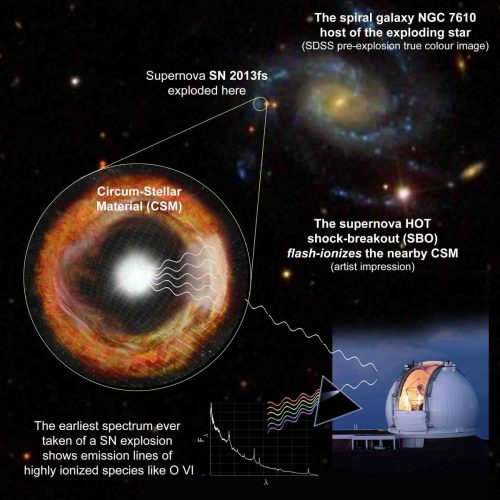A new series of observations by scientists from the Weizmann Institute and their research partners has identified processes of dynamic instability before the start of a supernova explosion

Only three hours after the start of the explosion of a star that is about ten times heavier than the Sun, in a relatively close spiral galaxy (160 million light years from us), scientists from the Weizmann Institute of Science and their research partners were able to notice this phenomenon, measure it and follow it. This is a series of observations that began in the shortest time so far since the start of a supernova explosion. These findings were published recently in the scientific journal Nature physics.
On October 6, 2013, a system that scans the night sky automatically using a telescope at the Mount Palomar Observatory in the United States detected an event taking place in a nearby galaxy, called NGC 7610. Shortly after the event was discovered, various telescopes around the world focused on it. Staff scientist Dr. Ofer Yaron, from the group of Prof. Avishai Gal-Yam In the Department of Particle Physics and Astrophysics, he analyzed, together with Prof. Eran Ofek and their research partners, the information collected. The researchers found that the event was the explosion of a "red supergiant" type star in a process they call a "type 2 supernova" - the most common process in star explosions, which ends with the star collapsing into itself - sometimes creating a black hole. According to the analysis, the star was surrounded by a ring of material ejected from the star itself during the year before the explosion, and this is evidence that the star that exploded as a supernova - the one named SN 2013fs - was unstable for some time before the final explosion.
"The fact that this event was discovered to be a fairly normal supernova indicates that processes of dynamic instability, which take place in massive stars before their final explosion, are common, and may give us important information for the questions of why stars explode"
Stars explode due to various types of processes, and astrophysicists are interested in them because from them it is possible to learn about the mechanisms of action and the "life cycle" of massive stars, as well as the characteristics of the environment in which the supernova is found and explodes.
Dr. Yaron emphasizes that the fact that this event was discovered to be a fairly normal supernova indicates that processes of dynamic instability, which take place in massive stars before their final explosion, are common, and may give us important information for the questions of why stars explode, and how this happens .

3 תגובות
If I understood correctly, then the supernova explosion happens in stages.
That is, a series of explosions that occur one after the other and last about a year.
With each explosion, the star sheds another shell of material and the nuclear combustion process of the next stage begins.
The last explosion is the strongest and brightest.
It is not only that the event happened more than 160 million years ago, but that today this system is already further away from us due to the expansion of the universe.
It's funny how we refer to an event that happened 160 million years ago in the present time ("an event that takes place in a nearby galaxy").